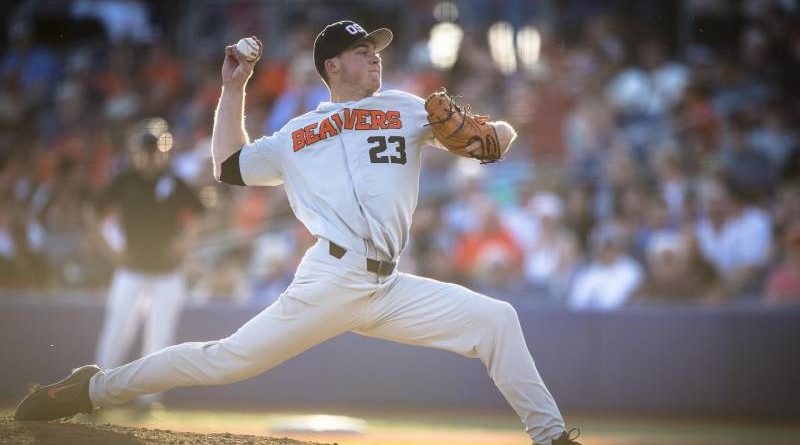Posted on April 9, 2020
![]()
By James Cleary, SuperWest Sports
It is a strange time to be alive. Less than a month ago, Pac-12 baseball teams were getting on airplanes and buses to travel to compete in their opening conference series of the 2020 season.
Today, players are scattered across the country trying to figure out a way to get workouts in. No team meetings, no batting practice, no bullpens.
 There will be no baseball season this year with the NCAA announcing a cancelation to the season in mid-March. Fans of UCLA and the Arizona schools have to be disappointed after watching their teams get off to blistering starts.
There will be no baseball season this year with the NCAA announcing a cancelation to the season in mid-March. Fans of UCLA and the Arizona schools have to be disappointed after watching their teams get off to blistering starts.
On the flip side, Stanford and Oregon State fans can breathe a sigh of relief after watching teams with high expectations start the season well short of those hopes. But what does the cancelation mean for college baseball as a whole?
With the announcement of no college baseball season in 2020, the flood gates opened to new unprecedented questions: Does that mean everyone loses a year of eligibility? What about the MLB Draft? How does that impact scholarship numbers? What about high school seniors and recruiting?
Here is what we know:
- College baseball players will get an additional year of eligibility.
- If a school chooses, any returning senior can get the same amount of scholarship money they received the previous year and that scholarship does not count against the team’s allotment of 11.7 scholarships.
- Seniors will not count against the 35 man roster limits or count against the total number of scholarship players which is set at 27.
- Finally, a school may decide to remove a senior’s scholarship completely or reduce the amount given to a senior for the additional year. The school may not increase the amount awarded.
While it makes sense to give everyone an extra year of eligibility, the decision will cause ripple effects for at least the next five years.
The incoming freshman class is going to consist of two classes, the 2020 class and the 2021 class. Playing time for incoming freshmen is going to be limited as they are now competing with an extra class.
 Beyond that, it is almost certain that the MLB Draft is going to be drastically shortened—to 10 or even five rounds—meaning that even more upperclassmen will be returning than normal.
Beyond that, it is almost certain that the MLB Draft is going to be drastically shortened—to 10 or even five rounds—meaning that even more upperclassmen will be returning than normal.
Overall, the product on the field should increase in quality. Teams are going to have more experience, more time in the weight room, and higher levels of maturity throughout.
If all goes well, players will have an extra season of summer ball under their belts. Older teams are going to have the experience and maybe even roster size advantage, but younger teams are going to have more time to mature over the course of the extended offseason.
New coaches within the league are going to have additional time to reflect on what they did well and what went wrong over the course of the pre-season.
With a few exceptions during these strange times, fans can take comfort in knowing they will soon see most of their favorite players back in uniform next year.

Maybe the most notable loss for the conference is the inability of fans to see ASU’s Spencer Torkelson play his final season of college ball. Torkelson hit six home runs during the short 2020 preseason and would have no doubt been the player to watch throughout the 2020 season.
Even with the condensed MLB Draft, there is little doubt that Torkelson will take the next step and move to pro ball as he is almost certain to be a top three overall pick.
Although the loss of Torkelson is significant, the Pac-12 is likely to enjoy another year of 2018 College World Series star Kevin Able on the mound for Oregon State in 2021. Because of the shortened draft, MLB teams will likely be hesitant to take players with a lot of risk.
Able, who likely projected as a high draft pick coming off Tommy John surgery, is the definition of high risk. When the MLB Draft rolls around, he will not have thrown a competitive inning for well over a year. The result is that he’s likely to go undrafted and return to Oregon State for an additional year—one there was very little chance of seeing otherwise.
Student-athletes, coaches, and even schools are all going to be put in difficult positions while forced to make difficult decisions as a result of this new reality. While us fans will miss sitting in the sunshine and watching our favorite teams for nine innings this year, you can be sure that the game will return next year stronger than ever.
—More from James Cleary—
- Cleary Mailbag: Why Pat Bailey wasn’t retained as an assistant at OSU
- MLB Announcement Changes Landscape of College Baseball
- Cleary: 2020 Pac-12 Baseball Predictions
- 2020 Pac-12 Baseball Preview: Utah Utes
- 2020 Pac-12 Baseball Preview: UW & WSU
- 2020 Pac-12 Baseball Preview: Oregon & OSU
- 2020 Pac-12 Baseball Preview: USC & UCLA
- 2020 Pac-12 Baseball Preview: Cal & Stanford
- 2020 Pac-12 Baseball Preview: Arizona & ASU
- Cleary: The Pac-12 is the SEC of Baseball
-
Cleary Mailbag: Why Pat Bailey wasn’t retained as an assistant at OSU
Plus questions about MLB Draft, last season's cancellations, and more - August 7, 2020 -
MLB Announcement Changes Landscape of College Baseball
The pro baseball league has dramatically reduced the 2020 draft from previous seasons - May 9, 2020 -
Cleary: Making Sense of a Lost Baseball Season
With extended eligibility, next season figures to be much different - April 9, 2020

